Gold & Precious Metals
Gold 2013 – A Must Read Snapshot
Posted by Martin Armstrong - Armstrong Economics
on Monday, 25 March 2013 14:11
We have a very serious problem. In gold, everyone is loaded to the gills expecting hyperinflation that will never materialize and governments are getting outright nasty. We have THREE Monthly Bearish Reversals that have now lined up in gold at 15470, 15413, and 15323. We have a huge gap from there to 11589 and this is not real good. Gold closed 2012 higher than it did for 2011 on the 13th year up. That is by no means good at all. If these reversals are elected, look out below. We may have to clean house before gold can resume the uptrend.
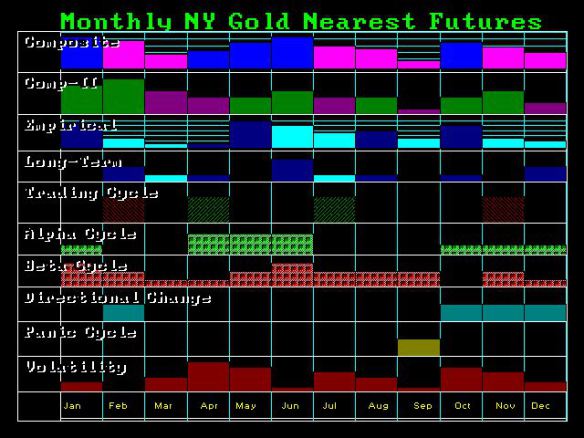
A snapshoot of the array for gold in 2013 came out as expected at the Berlin Conference. The Panic Cycle is September but look at the directional changes thereafter – every month. This is by no means going to be a walk in the park. The German elections are September 2013. Merkel is seen as the last hope for Europe even though she is really doing nothing of note but changing with the wind.
We will be preparing a new special metals report. It is obviously going to be needed right now. Will advise when it is ready.
Ed Note: The above as one in a series of 10 post Martin did for 2013. The rest are below here:
- Gold & 2013 (you just read that above – Ed)
- Dow Jones & 2013
- The Age of Materialism/Consumerism
- 2013 – The Roller-Coaster Ride of Your Life
- The Fate of Europe 2013
- Cycle of War & Political-Economy
- Beware the Taxman Cometh
- When I Was Wrong
- Can the World Really Abandon the Dollar As A Reserve Currency?
- Virginia Investigates Gold Back Currency as Alternative to the Dollar
- Cyprus – More than just a Debt Risk
- International Law & Territorial Jurisdiction
About Martin Armstrong
 Martin Armstrong was born in New Jersey the son of a lawyer and Lt. Col underGeneral Patton in World War II. Martin was encouraged by his father to get involved in computers during the mid-1960s. He completed engineering both in hardware and software but after being offered positions by a government contractor RCA in Thule Greenland, Guam, or Vietnam, he decided to go back to gold business that he had first began working while in High School to earn money for a family trip to Europe in 1964 for the summer. He continued to work on weekends through high school finding the real world exciting for this was the beginning of the collapse of the gold standard. Silver was removed from the coinage in 1965 and by 1968 gold began trading in bullion form in London. The gold standard collapse entirely in the summer of 1971 and gold became legal to trade in America during 1975 in bullion form. Previously, the market for gold had always been in coin form as long as they were dated prior to 1948.
Martin Armstrong was born in New Jersey the son of a lawyer and Lt. Col underGeneral Patton in World War II. Martin was encouraged by his father to get involved in computers during the mid-1960s. He completed engineering both in hardware and software but after being offered positions by a government contractor RCA in Thule Greenland, Guam, or Vietnam, he decided to go back to gold business that he had first began working while in High School to earn money for a family trip to Europe in 1964 for the summer. He continued to work on weekends through high school finding the real world exciting for this was the beginning of the collapse of the gold standard. Silver was removed from the coinage in 1965 and by 1968 gold began trading in bullion form in London. The gold standard collapse entirely in the summer of 1971 and gold became legal to trade in America during 1975 in bullion form. Previously, the market for gold had always been in coin form as long as they were dated prior to 1948.

….read and view much much more HERE

While Jamie Mackie, senior vice president and investment adviser with Macquarie Private Wealth, thinks the mining sector could sink further, he also believes now is the time to buy, carefully. In his first Gold Report interview, he discusses strategies to mitigate junior mining risk.
The Gold Report: Investing in mining equities is a cyclical play. Are we at a point in the cycle for investors to return to mining equities?
Jamie Mackie: I think the gold mining stocks are at or near the bottom. Research from the Ned Davis Research Group shows that pessimism is extremely high—typically an indication that we are close to a bottom. From our perspective, that is the best time to position yourself. Once the market begins to turn, it will happen rapidly. Investors need to recognize value and get in reasonably early to avoid paying up later.
I compare the situation to being at a huge party; the party being the blue chip, dividend-paying sector. The party has been going on for quite a while, and it is hard to leave the party and sit in a room all alone. But that is what investors should do, spend time in the room alone, waiting for others to join them.
TGR: From a wealth-building perspective, how do mining equities fit in a world that is deleveraging?
JM: Your choice of the word deleveraging is interesting because I would say the world as a whole is not deleveraging.
True, U.S. households have begun to deleverage, which has been positive for the market. Corporations have been deleveraging for some time, but now, due to artificially low interest rates, they are beginning to take on more debt.
Governments—except for those with austerity programs, like Greece, Ireland and Italy—have leveraged up massively. They are trying to make up for shortfalls in spending by corporations and consumers. Once governments ramp up spending, it is difficult for them to reduce expenditures later on. Governments are engaging in currency wars in an attempt to get their currencies down so their economies can compete globally. This is self-defeating. It inflates the money supply and puts downward pressure on the value of the currency.
Money printing is an insidious form of taxation on personal savings. People who want to protect against the ongoing depreciation of their savings need to have hard asset exposure. This process isn’t stopping. Witness the March 20 decision by the U.S. Federal Reserve to continue with the Quantitative Easing program. Owning quality mining and energy companies or the commodities themselves offers protection against this.
TGR: As a private wealth manager, how much of a typical portfolio are you allotting to junior mining equities?
JM: Right now, in the 2–3% range, so fairly modest. Our focus is more on energy equities right now
TGR: How do you counterbalance the risk junior mining equities represent
JM: Our approach to offsetting the risk in junior mining focuses on senior blue-chip and dividend-paying equities. Although as things get more expensive we are taking money off the table. As price/earnings ratios for specific equities get out of our comfort range, we want safer opportunities.
People often ask whether bonds would be a good risk offset. We view the bond sector as the most expensive, inflated bubble ever. Apart from very short duration bonds, we are on the sidelines?
Perhaps a better way to offset the mining stock risk is with a larger portion of physical gold, perhaps a 70/30 ratio. Of that 30% in equities, 70% would be in larger-cap equities and the rest in smaller, well-capitalized juniors.
TGR: How do you mitigate risk before you take positions in junior mining equities?
JM: Management is number one. Does management have skin in the game? It is important that management be aligned with our interests.
TGR: Do you have a rule of thumb for ownership percentage?
JM: The bigger percentage of management’s net worth, the better. Quality of the management team is really more important. Generally, if members of the management team are confident in their abilities and their projects, they will take significant positions
TGR: What other factors help you mitigate risk?
JM: Time to production is important. The mining sector has something we call the “valley of death.” A company has a great discovery, it takes six years to get into production; meanwhile, the stock plummets and the company cannot get financing. It is at 6–12 months before production that interest in the equity picks up again.
Then you look at the size of the ore body: Is the project big enough to attract the attention of an even higher-quality buyer? Is the project in a good jurisdiction? We have had what could be described as investment fatigue over political issues.
TGR: Investment fatigue is an interesting concept. Can you expand on it?
JM: When a government changes, the question becomes what one owns after the change. Egypt and Mali are two examples. Countries that follow British common law tend to be more stable from the point of view of jurisdiction and ownership. Russia is a country with a legal system quite different from British common law. It has been difficult to work in China from a property ownership point of view. Argentina’s somewhat erratic government has been tough.
Other countries—Peru, Colombia and Chile, for example—have improved a lot.
TGR: I would like to change the subject to royalties. You are fairly bullish on precious metals royalties. The royalty model is inherently lower risk than actual mining, but royalty companies typically have a lot of exposure to movement in metals prices. What is your outlook for gold and silver prices for the rest of 2013?
JM: The party going on in the blue-chip, dividend-paying equities has resulted in an exodus from the mining sector and from the gold exchange-traded funds (ETFs) into stocks that generate income. The resulting sales of gold drove the gold price down.
On the other hand, physical gold is being bought by longer-term, stronger investors, i.e., the Chinese, Indian and other developing countries’ governments, as well as individuals there. Private investors seeking insurance against currency debasement are buying the commodity, too. The ETF liquidations will cease at some point in the near future so in two to six months out we should see stronger gold prices, mid-$1,600/ounce (mid-$1,600/oz) or higher.
Silver is different. It has industrial uses, including some pretty healthy growth areas, such as electronics and water treatment. A lot of its uses are consumptive, and although there is some recycling, a lot of silver disappears. The ETF market has not been nearly as big on the silver side, and therefore not as disruptive as the gold ETFs. By year-end, silver could be, on a percentage basis, somewhat higher than today.
TGR: Could it push $35/oz by year-end
JM: Silver is a volatile market. There will be spikes and retrenchments, but it could get there
TGR: How do royalty companies benefit from resource expansion on their mining properties
JM: That is the big upside on royalty companies. In most of the projects they finance, they are buying into a royalty stream based on resources outlined in an NI 43-101.
Gold mining companies tend not to make capital expenditures to develop new reserves on their existing properties until they need to. Once a project is up and running smoothly, and the company has paid down some debt or proven that the economics are justifiable, it will drill up the surrounding land and get more reserves from that.
The streaming company gets huge upside on the pure future development of the mine
TGR: Smaller royalty players have entered the market. Do they offer value or are they simply trying to piggyback on the success of the larger names?
JM: I am sure there is some mimicry of larger royalty companies. However, given the disarray in the mining sector and the dearth of capital on the junior side, there is an opportunity for smaller royalty companies to structure really attractive deals. There are just a handful of royalty companies.
TGR: What advice would you give retail investors that they ought to hear, but might not want to hear?
JM: The stock market is massively fickle and the mining sector is in difficult times that could prevail for an extended period. In the long run, this is a self-correcting event. Mines will be delayed if things carry on as they are until demand returns, grows, and outstrips supply.
Further decreases in the commodity price will damage equity values. Strong companies have the upper hand, and at some point, they will use it. They will find and purchase the best projects, although we have not seen much merger and acquisition activity lately.
I think even the big companies are shell-shocked. They have had huge cost escalation in projects and are looking to finish them before taking on others. That has been a real wet blanket on the junior mining sector.
The world keeps growing, along with demand for commodities. Currencies will continue to be debased. Inflation will begin to drive commodity prices higher.
The biggest question right now is when. Nobody has a good answer. The inflation numbers provided by governments are nowhere close to accurate. Good measures might be the cost of building a mine or the associated operating cost. If the costs were the prescribed inflation rate of 1.5%, the mining sector would not be having such huge cost overruns.
If you take a position in the junior mining sector, you have to be patient, although patience does not seem to be a virtue in the current market.
TGR: Jamie, thank you for your time and your insights.
Jamie Mackie has more than 33 years of experience in the investment banking and oil and gas industries to his position as senior vice president and senior investment adviser with Macquarie Private Wealth. He was founding partner and director of Finance of First Energy Capital Corp. and co-founder of Wilson Mackie and Company Inc. Prior to forming J.F. Mackie, which evolved into Mackie Research Capital Corp., he was an investment adviser with National Bank Financial Corp., previously First Marathon Securities. He worked at Suncor, Hudson Bay Oil and Gas, Dome Petroleum and Canadian Hunter on both the commercial and technical sides of the business. He holds degrees from the University of Calgary and a Master of Science in resource management from Yale University.
DISCLOSURE:
1) Brian Sylvester conducted this interview for The Gold Report and provides services to The Gold Report as an employee or as an independent contractor.
2) Streetwise Reports does not accept stock in exchange for its services or as sponsorship payment.
3) Jamie Mackie: I was not paid by Streetwise Reports for participating in this interview. Comments and opinions expressed are my own comments and opinions. I had the opportunity to review the interview for accuracy as of the date of the interview and am responsible for the content of the interview.
4) Interviews are edited for clarity. Streetwise Reports does not make editorial comments or change experts’ statements without their consent.
5) The interview does not constitute investment advice. Each reader is encouraged to consult with his or her individual financial professional and any action a reader takes as a result of information presented here is his or her own responsibility. By opening this page, each reader accepts and agrees to Streetwise Reports’ terms of use and full legal disclaimer.
6) From time to time, Streetwise Reports LLC and its directors, officers, employees or members of their families, as well as persons interviewed for articles and interviews on the site, may have a long or short position in securities mentioned and may make purchases and/or sales of those securities in the open market or otherwise.

Technical Picture
Gold bounced off $1,560 a target that it had held for the last year and more. It consolidated at $1,580 and has now tackled $1,600.The bounce was off the long-term trend line. While resistance in the higher $1,600 area could be formidable a look at the reasons why it fell through support at $1,650 is worthwhile.
Recent Fundamentals
The prime cause of the gold price falling so much in the last few months, has been the over 100 tonnes of sales from the SPDR gold Exchange Traded Fund, an amount that triggered a considerable amount of stop loss selling.
While central banks have been buying, their way of buying is to target available volumes of gold sitting in the market. Dealers with gold contact central banks and make an offer, which is accepted. Central banks don’t chase prices and find their stock as prices fall. This takes gold off the market leaving smaller amounts for buyers once the gold price turns up.
A negative fundamental that has surprised many is the fall off in Indian demand as the government there raised duties on gold and have required “know your client” documentation on large retail purchases of gold. With their hatred of exposing their finances to government scrutiny, these measures have and are slowing Indian demand. But India is no stranger to buying gold when their government doesn’t want them to. So they will be back, even if we won’t be able to accurately quantify their buying in the future.
…..read more HERE

Next US$ Peak is Catalyst for Precious Metals & Hard Assets
Posted by Jordan Roy-Byrne - Daily Gold
on Friday, 22 March 2013 13:39
Our title seems obvious. We all know that the US$ tends to be negatively correlated with commodity prices. This is true in the short-term but not always so over the long-term. The US$ index is currently nearing 83. It’s at the same level it was in 2007 when Gold was trading in the $600s and the CCI (currently 554) was trading near 400. The US$ index is near the same level it was at the end of 2005 when Gold was trading below $400 and the CCI was trading below 300. This tells us that the bull market in precious and hard assets goes way beyond simple US$ weakness. It is driven by long-term supply and demand dynamics as well as rampant monetary inflation from global parties and not just the USA. Throughout this bull market, key advances and turning points have originated from strength against foreign currencies and then sustained strength amid textbook US$ weakness.
First let’s take a look at Gold priced in US$ and then Gold priced against the inverse of the US$ (a foreign currency basket represented by the ETF UDN). Note that Gold/UDN is often a leading indicator for Gold in US$. Gold/UND bottomed in the summer of 2008 and made a higher low in October, when Gold bottomed. Gold/UDN broke to new highs in early 2009 while Gold didn’t break to new highs until September 2009. The same happened in early 2010 as Gold/UDN brokeout first. At present, there are no major divergences but Gold/UDN has been quite a bit stronger than Gold in recent weeks.
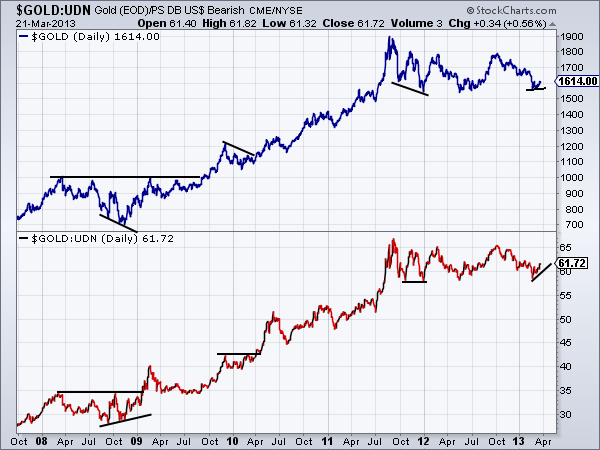
Meanwhile, we have similar observations when looking at commodities via the CCI and UDN. During 2010 CCI/UDN broke to new highs in the spring while CCI didn’t breakout until September. CCI/UDN peaked ahead of the CCI by a few months in early 2011. Currently, CCI/UDN is showing a positive divergence. A close above 22 would be quite telling as commodities would be at 18-month highs when priced against foreign currencies.
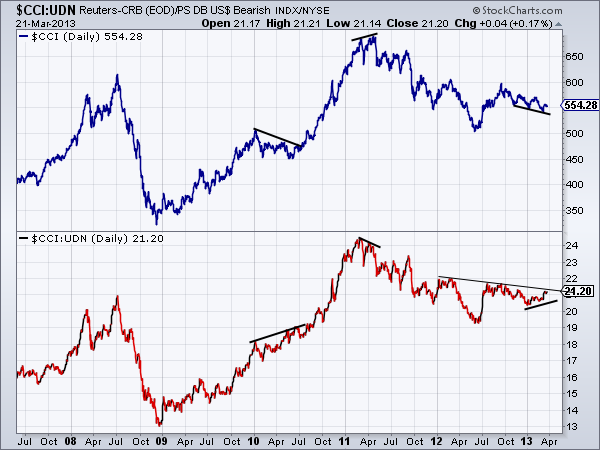
In terms of sentiment, we already know the depths of Gold and the heights of the equity market. The chart below (source) shows the CCI with the positioning of fund managers as surveyed by the monthly Bank of America Merrill Lynch fund manager survey. The current weighting of commodities (in the average fund manager portfolio) is the second lowest in four years!
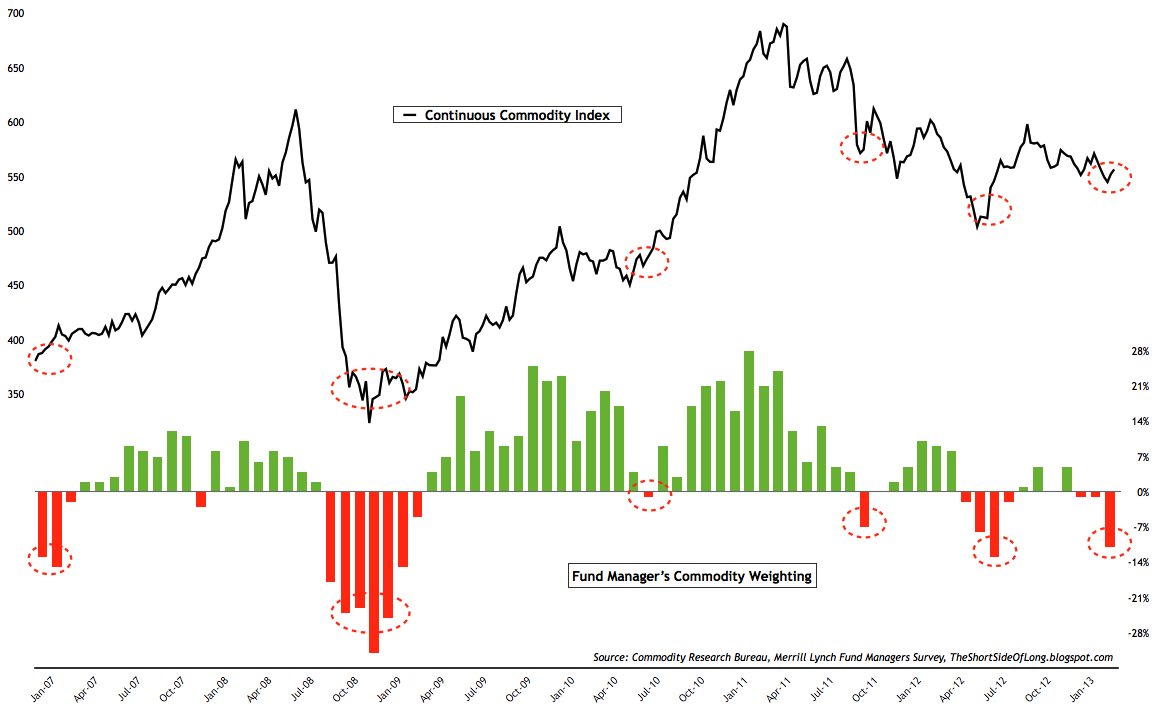
Meanwhile, as you’d expect given the skepticism on commodities, sentiment for Uncle Buck has grown more bullish. As per sentimentrader.com, public opinion is currently at 75% bulls. Peaks in the US$ have occurred with public opinion at 80% bulls. The US$ has a bit more upside until resistance at 87-88.
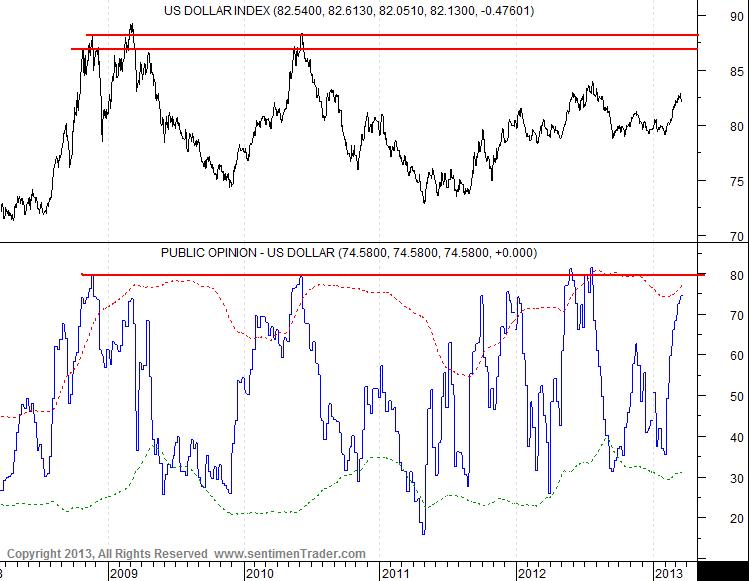
Moving back to our original point, the US$ plays an important role in commodity markets but is not the sole determinant of exact peaks and bottoms. In fact, the US$ is usually a lagging indicator for Gold and gold stocks as shown below. We plot the US$ inverse, Gold and the HUI. The blue line shows the important bottoms in Gold and the HUI and the red line shows the corresponding bottoms in the US$ inverse. Essentially, the precious metals market will form major bottoms ahead of tops in the US$.
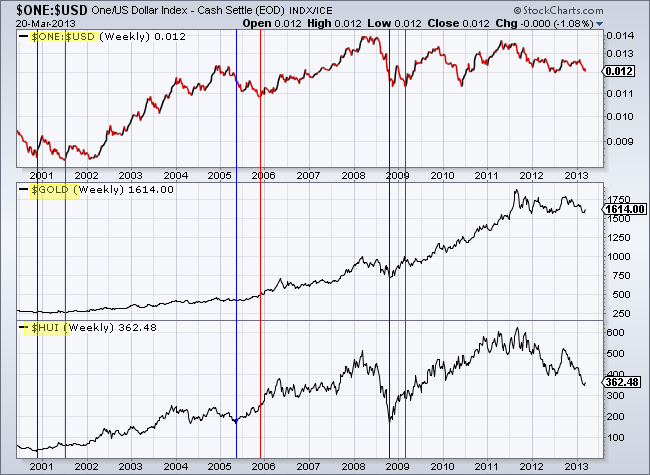
What does all this mean going forward? We believe that 2013 will mark an important transition year as the equity market is likely to make a cyclical peak while commodities make an important cyclical bottom. We already know that sentiment on commodities and precious metals is at dumpster diver type levels. Adjust for the US$ strength and it’s clear that these markets are showing some short-term strength amid poor sentiment. That is a positive sign and one we often see ahead of key turning points in these markets. However, the US$ has some more upside before its next important peak. Precious metals have found a bottom and are moving higher, but they won’t embark on their next big move until the US$ peaks. We’ve carefully added to longs in recent weeks but will remain patient in our anticipation of the next big leg higher later this year. If you’d be interested in professional guidance in uncovering the producers and explorers poised for big gains in the next few years then we invite you to learn more about our service.
Good Luck!
Jordan Roy-Byrne, CMT

200 Years Of The Dow/Gold Ratio Suggest Staggering Moves Dead Ahead
Posted by Tekoa Da Silva: Bull Market Thinking
on Thursday, 21 March 2013 14:09
One of the more fascinating reminders of what may be to come for the remainder of this gold bull market, is the charted history of the dow/gold ratio. Below are two charts illustrating the upward potential in gold which remains for the duration of this market.
Here is the second and more alarming dow/gold ratio chart, illustrated with a “confidence trend band”:
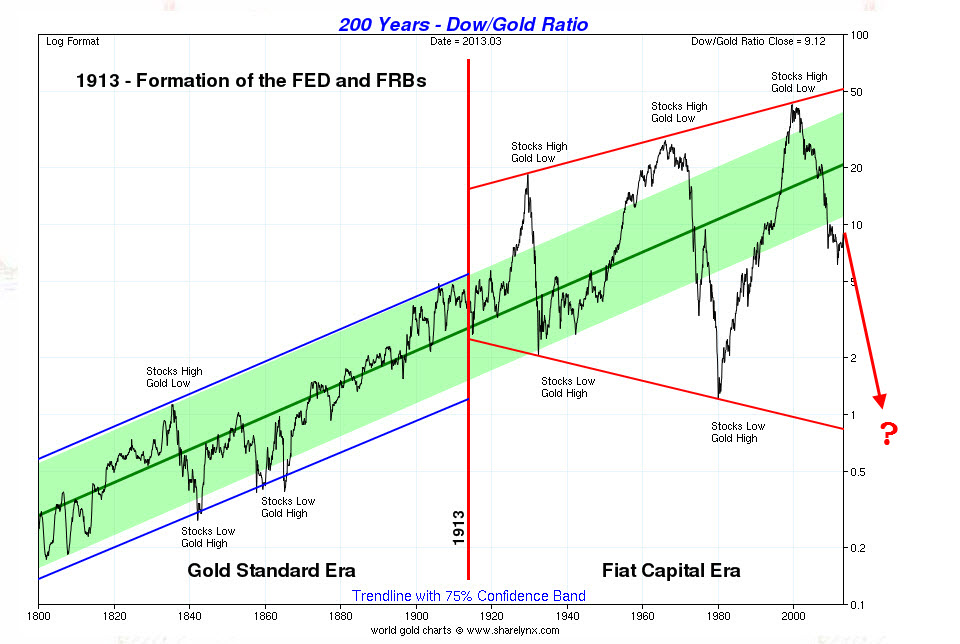
…..read more HERE


-
I know Mike is a very solid investor and respect his opinions very much. So if he says pay attention to this or that - I will.
~ Dale G.
-
I've started managing my own investments so view Michael's site as a one-stop shop from which to get information and perspectives.
~ Dave E.
-
Michael offers easy reading, honest, common sense information that anyone can use in a practical manner.
~ der_al.
-
A sane voice in a scrambled investment world.
~ Ed R.
Inside Edge Pro Contributors

Greg Weldon

Josef Schachter

Tyler Bollhorn

Ryan Irvine

Paul Beattie

Martin Straith

Patrick Ceresna

Mark Leibovit

James Thorne

Victor Adair
